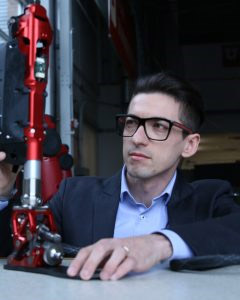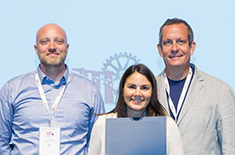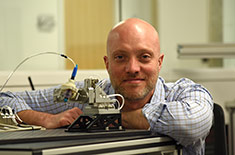Congratulations to Profs. Abbott, Kong, Leang and Monson on their new $2M NSF EFRI Award, project in collaboration with R. Rajamani of Univ. of Minnesota and O. Pak of Santa Clara Univ. Project tile: “EFRI C3 SoRo: Magneto-electroactive Soft, Continuum, Compliant, Configurable (MESo-C3) Robots for Medical Applications Across Scales” The vision of this collaborative project between the University of Utah, the University of Minnesota, and Santa Clara University is to extend the capabilities of clinicians by enabling minimally invasive access to locations in the human body that are currently difficult or impossible to reach, using a new class of...
Read MoreProf. Jake Abbott’s work on magnetic capsule endoscope featured in PCMag.com
Prof. Jake Abbott’s work on magnetic capsule endoscope featured in an article in PCMag.com: https://www.pcmag.com/news/363730/this-robot-might-make-invasive-colonoscopies-a-thing-of-the ...
Read MoreProf. Lenzi receives $972K DoD CDMRP grant for motorized hip orthoses
Congratulations to Prof. Tommaso Lenzi for receiving new $972K DoD CDMRP grant entitled, “Motorized Hip Orthoses to Improve the Gait Ability of Transfemoral Amputees”. The goal of the project is to validate a new approach to improving amputees’ mobility—providing bilateral hip assistance with a motorized orthosis. Hip orthoses are very lightweight, and their mass is located close to the body center of mass, thus minimizing the metabolic energy cost of carrying this additional weight. In addition, as the orthosis is not suspended through the socket interface, it does not affect balance or socket stability. Because motorized hip orthoses can be...
Read MoreRobotics Ph.D. Student, Dejun Guo, Wins 2017 ASME Dynamic Systems and Control Conference (DSCC) Best Student Paper Award
Robotics Ph.D. student, Dejun Guo (pictured on the right), advised by robotics faculty Kam K. Leang (pictured on the left) and member of the DARC Lab, University of Utah Robotics Center, won the 2017 American Society of Mechanical Engineers (ASME) Dynamic Systems and Control Conference (DSCC) Best Student Paper Award, held October 11-13, 2017 in Tysons Corner, Virginia. This conference and competition represent the best of the brightest minds in the field. For reference, the other finalists were from Texas A&M University, Villanova University, MIT/Northeastern University, UC Berkley, and University of Texas at Dallas. Co-authored by Prof. Leang, Guo’s paper entitled, “Position and Linear Velocity Estimation for Position-Based Visual Servo...
Read MoreMechanical Engineering – Tenure-Track Faculty Position in Robotics
Mechanical Engineering – Tenure-Track Faculty Position in Robotics The University of Utah Robotics Center (robotics.coe.utah.edu) is seeking outstanding candidates with research interests and expertise in robotics and related systems, for a tenure-track appointment at the assistant or associate rank in the Department of Mechanical Engineering with a Fall Semester 2018 starting date. Candidates with exceptional background and experience may be considered at a higher rank. Candidates must have an established record of published research, must exhibit strong potential for extramural funding within their area of expertise, and are expected to develop a vigorous research program. Candidates must also be qualified to teach...
Read MoreHermans’ and Abbott’s ISRR 2017 papers accepted
Two papers by robotics faculty were recently accepted to the International Symposium on Robotics Research (ISRR): “Planning Multi-Fingered Grasps as Probabilistic Inference in a Learned Deep Network” by Qingkai Lu, Kautilya Chenna, Balakumar Sundaralingam, and Tucker Hermans. “Controlling Homogeneous Microrobot Swarms In Vivo Using Rotating Magnetic Dipole Fields”, by Jake J. Abbott and Henry C. Fu ...
Read MorePopek, Hermans, and Abbott Win Best Paper Award in Medical Robotics at ICRA 2017
Katie Popek, Tucker Hermans, and Jake Abbott’s paper entitled, “First Demonstration of Simultaneous Localization and Propulsion of a Magnetic Capsule in a Lumen Using a Single Rotating Magnet,” was recently awarded the Best Paper Award in Medical Robotics at the 2017 IEEE International Conference on Robotics and Automation (ICRA) in Singapore. ICRA is the largest annual international robotics conference, and is the flagship conference of the IEEE Robotics and Automation Society. Abbott is an associate professor in the Department of Mechanical Engineering, Hermans is an assistant professor in the School of Computing, and Popek recently earned her Ph.D. in Computing (Robotics Track) while conducting research...
Read MoreResearch paper by robotics student Sundaralingam and Prof. Herman on manipulation accepted for publication in Robotics: Science and Systems (RSS)
Balakumar Sundaralingam’s and Tucker Hermans’ research paper entitled, “Relaxed-Rigidity Constraints: In-Grasp Manipulation using Purely Kinematic Trajectory Optimization” was recently accepted in Robotics: Science and Systems (RSS), 2017. Congratulations!...
Read MoreProf. Hermans receives new NSF CRII award for $175,000, project entitled, “CRII: RI: Enabling Manipulation of Object Collections via Self-Supervised Robot Learning”
Congratulations to robotics faculty Prof. Hermans for receiving new NSF CRII award for $175,000. The project is titled, “CRII: RI: Enabling Manipulation of Object Collections via Self-Supervised Robot Learning” Project ABSTRACT: While manipulation of individual objects in cluttered, real-world settings has received substantial attention, the problem of directly manipulating collections of objects has been left unexplored. This project investigates to what extent robots can autonomously manipulate such object collections. This project facilitates autonomous manipulation methods suitable for use in home robotic assistants. Such assistive robots stand to make a substantial impact in increasing the quality of life of older adults...
Read MorePopek, Hermans and Abbott ICRA 2017 paper selected as one of the finalists of Best Medical Robotics Paper Award
Katie Popek, Tucker Hermans and Jake Abbott’s submitted paper entitled: “First Demonstration of Simultaneous Localization and Propulsion of a Magnetic Capsule in a Lumen Using a Single Rotating Magnet” has been selected as one of the finalists of Best Medical Robotics Paper Award of ICRA 2017. Congratulations to Katie, Tucker and Jake!...
Read More




